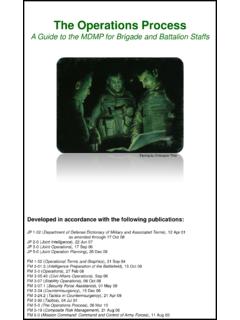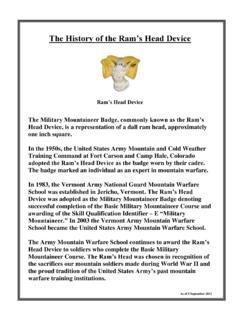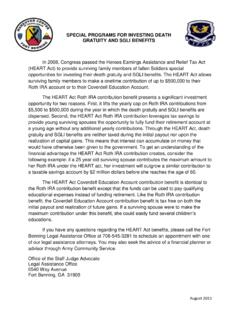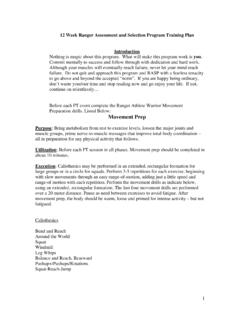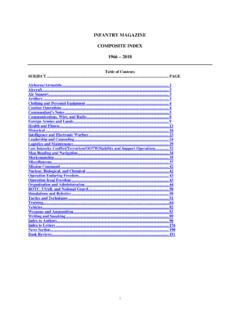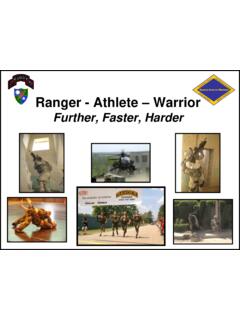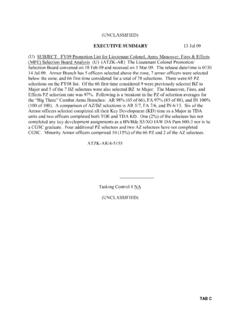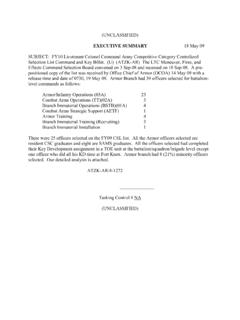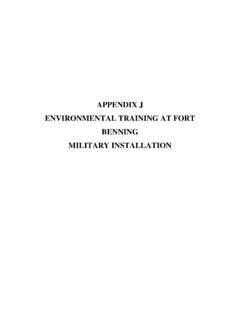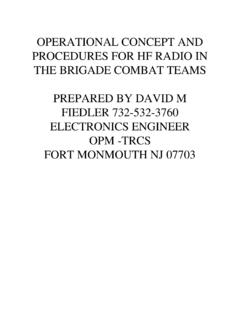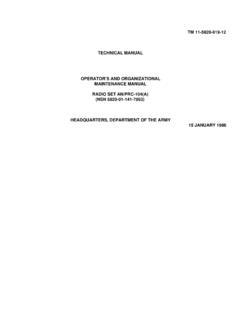Transcription of The Military Decision-Making Process: a Blueprint for ...
1 The Military Decision-Making Process: a Blueprint for Developing Your Unit s Mission-Essential Task List Crosswalk by CPT Jonathan Hawkins The Army has developed and maintained a set of doctrine since its inception. It has constantly expanded and refined this doctrine to ensure it remains a relevant point of reference in an ever-changing environment. Despite having unlimited access to this doctrine, however, leaders are often quick to look elsewhere to address a problem or challenge. Conducting a thorough and applicable mission-essential task list (METL) crosswalk is one of these problems leaders face a problem that can be solved through the application of a commonly used piece of doctrine.
2 The most effective method of executing an accurate METL crosswalk that facilitates training management within a unit is through the use of the Military Decision-Making process (MDMP). Executing a METL crosswalk using the MDMP in turn facilitates the execution of troop-leading procedures (TLPs) at the company/troop/battery level. Each unit has a list of tasks, dictated by the Army, that it is expected to be able to perform. This list of tasks, known as a METL, is the guiding force behind a unit s training and should be an integral part of the training-management process. Conducting a crosswalk of these tasks down to the individual level is critical to a unit s ability to plan, execute and manage meaningful training that effectively builds proficiency in those Army-directed tasks.
3 Once an accurate crosswalk is executed, it can be applied in several ways that facilitates parallel planning and builds efficiencies within a unit s training-management system. This article identifies critical gaps in the typical method of executing a METL crosswalk; proposes an alternate, doctrinal-based method; and provides practical ways to apply the crosswalk in everyday operations. Crosswalk steps A thorough METL crosswalk is executed in two steps: inform and conduct. Too often these two steps are merged into one and leadership fails to be applied to the process. The inform step is what most are accustomed to: accessing the Combined-Arms Training Strategies (CATS) Website ( #) or another resource and researching, by task, what individual tasks are nested within a collective task according to that particular source.
4 While this process is important, it is only the initial step toward executing an accurate crosswalk of mission-essential tasks (MET). The second step, conduct, is what gets left out most of the time. This step requires leaders to be more subjective, looking specifically at their mission set and applying the knowledge and experience held within their organization to ensure tasks are properly nested. This is where the application of the MDMP is most effective, enabling leaders at echelon to account for all factors and allowing commanders to remain central throughout the process. It is through informing and conducting that accurate METL crosswalks are built and proper nesting of tasks between echelons can occur.
5 The first step in building a METL crosswalk is to inform. During this step, commanders and other leaders look objectively at what individual tasks must be trained to service a collective task. By doing so, leaders establish a base of understanding into the training that must be executed, at echelon, to build proficiency in their respective METs. Here, commanders implement the science of control, which is based on objectivity, facts and empirical methods 1 and is critical in building an accurate association between collective and individual tasks. There are several resources available to help facilitate this process.
6 These resources, which include CATS, Digital Training Management System (DTMS) and training circulars (TCs), break down collective tasks into a list of individual or lower echelon tasks, making it easy to document and use as a reference moving forward. CATS, in particular, organizes tasks based first on branch or unit type, then by echelon. CATS not only breaks down collective tasks to individual tasks but also provides training and evaluation outlines that list the performance measures required for each task to be trained. CATS and similar databases are phenomenal resources that leaders should reference while developing a crosswalk, but not solely rely on.
7 As with anything else, these resources have gaps in capabilities that make the second step in the crosswalk process absolutely critical. There are several capability gaps in the resources used in the inform step that prevent commanders and other leaders from exclusively relying on them to execute their METL crosswalk. The largest deficiency is that these resources are void of any subjective analysis and fail to apply factors that might affect a particular unit s crosswalk. One way this is evident is how tasks are prioritized. Executing a crosswalk purely using CATS or another resource typically causes leaders to rank the importance of their tasks based on the number of collective tasks that are serviced instead of what might be uniquely important for their particular unit.
8 For example, Table 1 depicts an armor company s high-to-low payoff tasks based on the commander s crosswalk. Conduct TLP is at the top, as training that task at the platoon level services the most supporting collective tasks (SCTs) at the company level. Conduct a movement-to-contact, meanwhile, is prioritized at the bottom of the list because, due to the narrow focus of the task itself, it only services a small number of SCTs. 1-4 Low-payoff collective task 5-9 Medium-payoff collective task >10 High-payoff collective task Platoon CCTs 1 Conduct TLPs (171-121-4045) 2 Conduct rehearsal (07-2-5009) 3 Integrate direct fires (07-2-3027) 4 integrate indirect-fire support (07-2-3036) 5 Conduct tactical movement (07-2-1342) 6 React to contact (07-3-D9501) 7 Conduct consolidation and reorganization (07-2-5027) 8 Conduct a passage-of-lines as the passing unit (07-2-9006) 9 Evacuate casualties (08-2-0004) 10 Treat casualties (08-2-0003) 11 React to indirect fire (07-3-D9504)
9 12 Conduct a movement-to-contact (07-2-1090) 13 Conduct area defense (07-2-9003) 14 Occupy an assembly area (07-2-9014) 15 Conduct attack-by-fire (07-2-1256) Table 1. An example of an armor company s high-low payoff tasks. Also see TC , Tank Platoon Collective Task Publication, July 2013. Relying on CATS alone to do a METL crosswalk removes the commander from the process and instead relies on quantitative data to determine what tasks are most important. Given some analysis, this commander could determine that, although conduct a rehearsal is an important task, his platoons ability to conduct a passage-of-lines is more important based on his company s mission.
10 CATS shortcomings Another gap in the capabilities of these resources is the failure to account for unique units or units in uncommon situations. Currently, CATS and similar resources serve as a one size fits all database that treats every like unit the same. This, however, is clearly not the case for several units. For example, one armor company in every armored brigade combat team (ABCT) across the Army has moved under the cavalry squadron as part of the Army s K-series modified table of organization and equipment. This creates an obvious difference in mission set, responsibilities and expectations of that armor company.
